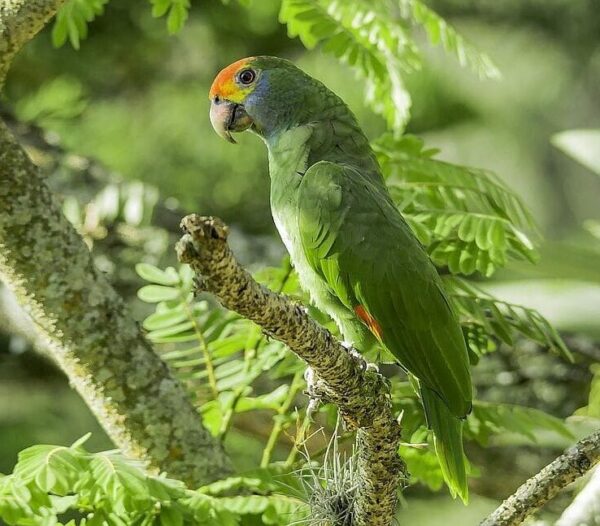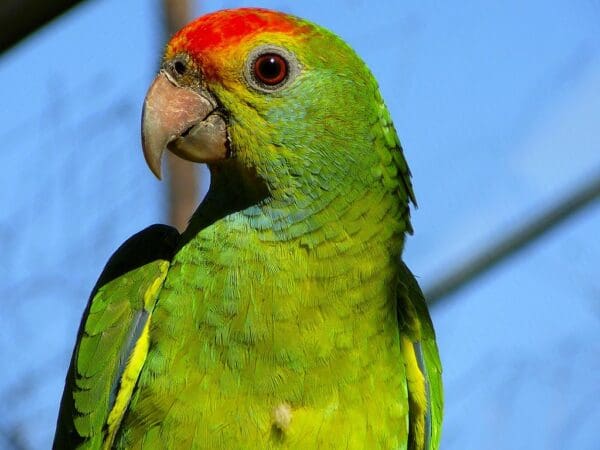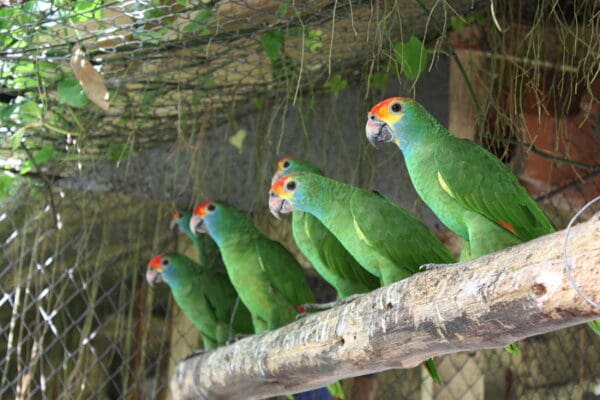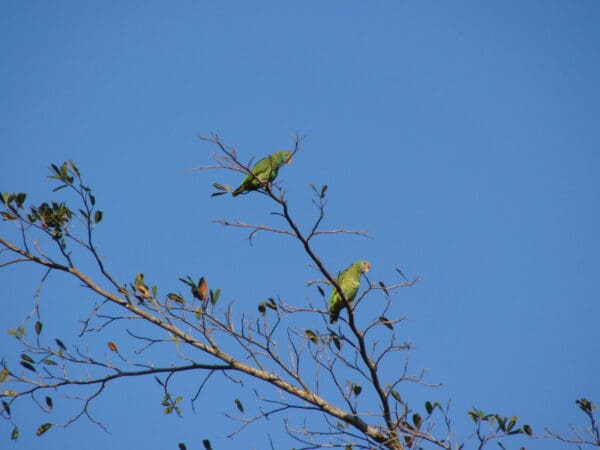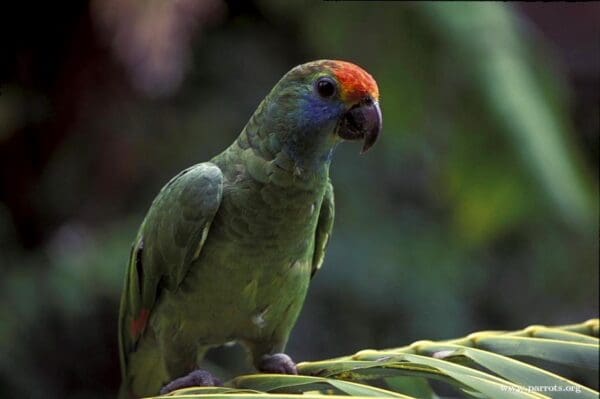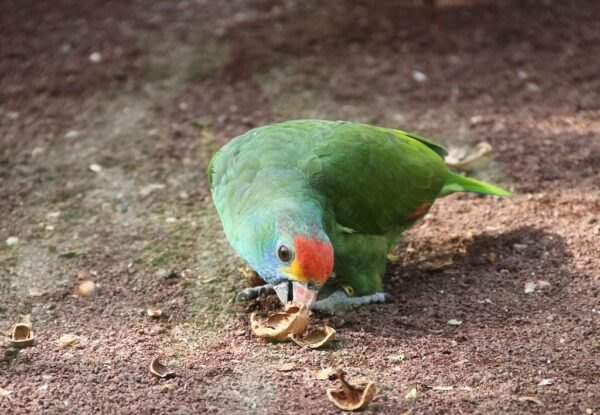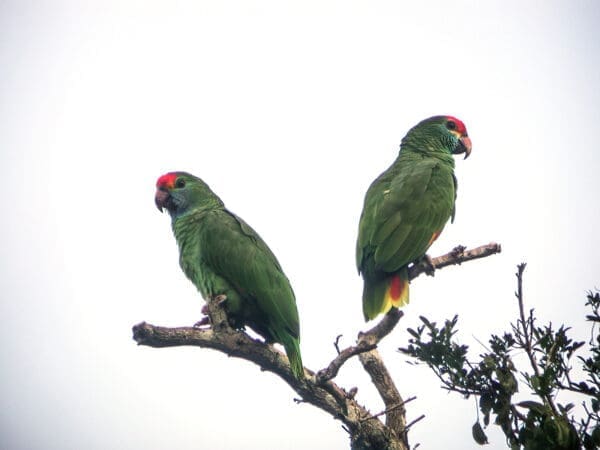Red-browed Amazon
Also known as:
Red-crowned Amazon (Parrot), Red-topped Amazon (Parrot), Red-capped Amazon (Parrot)
Also known as:
Red-crowned Amazon (Parrot), Red-topped Amazon (Parrot), Red-capped Amazon (Parrot)

![© Duncan Rawlinson (flickr) [CC BY 2.0] via Wikimedia Commons](https://parrots.org/wp-content/uploads/2023/01/wpt_Red-browed-Amazon_1121-14-100x100.jpg)

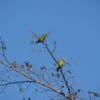
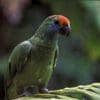
![© SBjoertvedt [CC BY-SA 4.0] from Wikimedia Commons A Red-browed Amazon forages on the ground](https://parrots.org/wp-content/uploads/1990/10/Red-browed-Amazon-Bjoertvedt-100x100.jpg)
![© Nick Athanas [CC BY-SA 2.0] via Flickr Wild Red-browed Amazons perch atop a tree](https://parrots.org/wp-content/uploads/1990/10/Red-browed-Amazon-lg-Nick-Athanas-100x100.jpg)
DID YOU KNOW?
The Red-browed Amazon sometimes feeds and roosts with Orange-winged Amazons.

Amazona

rhodocorytha
Size:
35 cm (13.6 in)
Weight:
450 g (15.7 oz)
Subspecies including nominate:
one
Colour Adult:
Both adults green with red forehead and crown, a few crown feathers tipped green/blue; black edging to feathers of neck; red/purple feathers on occiput, tipped with black and tinted with blue; nape feathers green tinted with dull red/purple and tipped with black; orange/yellow lores to forecheeks with red tinge; throat and upper cheeks blue; carpal edge green/yellow; secondary feathers 1-3 red at the bases; green tail, the side feathers widely tipped with yellow/ green and banded red just before end, outermost feathers margined with purple/blue. Beak grey with pink/red at base of upper mandible. Eye ring grey, eye orange.
Colour Juvenile:
As in adult but with hindcrown becoming washed with green; occiput to back of neck green, the feathers edged black; yellow lores; ear coverts to forecheeks and throat blue; little red on the bases of the two outermost secondary feathers; little red on side tail feathers. Beak pale pink tipped with grey/white. Eye brown.
Call:
Varied calls, usually raucous and continuous.
More Information:
Content Sources:
CITES
BirdLife International
Cornell Lab of Ornithology/Birds of the World
Parrots: A Guide to Parrots of the World, Juniper and Parr, 1998
Parrots: Status Survey and Conservation Plan 2000-2004, Snyder, McGowan, Gilardi and Grajal, 2000.
Parrots of the World, Forshaw, 2006. 2010 edition
Vanished and Vanishing Parrots, Forshaw, 2017.
Parrots in Aviculture, Low, 1992.
Parrots: Their Care and Breeding, Low, 1986.
Psittacine Aviculture, Schubot, Clubb and Clubb, 1992.
Captive Status:
Very rare.
Longevity:
—
Housing:
Walk-in aviary, minimum length of 4.5 m (14.7 ft); aviary or suspended enclosure, minimum length 3 m (9.8 ft).
Diet:
Fruit such as: apple, pear, orange, banana, cactus fruits, pomegranate, forming about 30 % of the diet; fresh vegetables such as: carrot, celery, green peas, beans, fresh corn, green leaves; spray millet and limited mixed seed, cooked beans and pulses, complete kibble – is prone to obesity so very limited fattening seeds.
Enrichment:
—
Nest Box Size:
12″ x 12″ x 24″ (30.5 cm x 30.5 cm x 61 cm) vertical box.
Clutch Size:
Up to 4.
Fledging Age:
Around 8 weeks.
Hatch Weight:
—
Peak Weight:
—
Weaning Weight:
—
World Population:
2500-10,000 mature individuals, decreasing.
IUCN Red List Status:
Vulnerable
CITES Listing:
Appendix I
Threat Summary:
This species is restricted to 2700 km2 in the Atlantic Forest of Brazil, in E Minas Gerais, N São Paulo, Rio de Janeiro, Espírito Santo, Bahia and Alagoas. Threatened by deforestation and fragmentation of habitat (only 2% of the species’ overall habitat is estimated to remain). Also affected by trapping for wild bird trade.
Range:
East coast of Brazil, most likely extinct in state of Rio de Janeiro; NE Bahia and E Minas Gerais to Espirito Santo and N Sao Paulo.
Habitat:
Found in humid lowland forests; also reported in highlands seasonally. Occurs up to 1000 m (3280 ft).
Wild Diet:
Fruits, seeds, berries and buds from tree-tops. Has been recorded feeding on papaya, jackfruit, mango, cocoa, banana and coffee plantations.
Ecology and Behaviour:
Birds keep to the upper stages of the forest canopy, feeding in pairs and small groups. Congregates in nighttime roosts.
Clutch and Egg Size:
Up to 4 eggs (39.4 x 30.6 mm)
Breeding Season:
Likely September-November in tree cavities.
Related Links:
—
